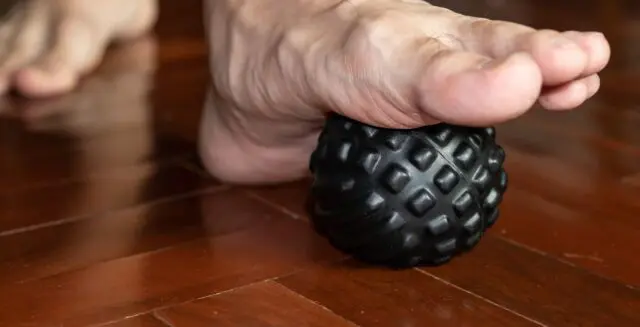Plantar fasciitis is a painful condition that affects the band of tissue known as the plantar fascia, a band of connective tissue that connects the toes to the heel bone and helps support the arch of the foot. This occurs when the plantar fascia becomes inflamed or damaged and can be debilitating and negatively affect the ability to perform daily activities. Luckily, when we talk about plantar fasciitis, there are exercises that can alleviate its symptoms and prevent its appearance.
The symptoms of plantar fasciitis are diverse. Among them, we find sharp pain at the bottom of the heel, especially when getting up in the morning or after sitting for a long time.
As for their causes, they are also varied. These include repetitive overload, poor posture, being overweight, and the wear and tear of connective tissue.
Some common symptoms of plantar fasciitis include:
• Pain in the bottom of the foot, especially on the inside of the heel.
• Pain when walking or standing for long periods of time
• Sharp pain or stinging sensation on first step after resting
• Pain that may get worse after exercising or climbing stairs.
Common causes of plantar fasciitis are:
• Overload on the feet due to intense physical activity or a sudden increase in physical activity
• Flat feet or high arches
• Wearing shoes with insufficient support or shoes that are worn out
• Overweight or obese
• Advanced age
• Pre-existing medical conditions, such as arthritis or diabetes
According to a study published in the journal “Foot and Ankle International” in 2011, plantar fasciitis is one of the most common causes of foot pain and is more common in people who are physically active or who have a job. that requires standing or walking for long periods of time. This is due to the impacts and the overload that the plantar fascia suffers and that ends up leading to this ailment.
How to prevent plantar fasciitis?
Plantar fasciitis is a painful condition that can be difficult to treat. Therefore, it is important to know some tips to prevent its appearance.
A study published in the Journal of Foot and Ankle Surgery in 2014 found that early and proper treatment, such as physical therapy and strengthening exercises, can help alleviate the symptoms of plantar fasciitis and prevent future complications. In addition, we can carry out different prevention strategies to avoid this type of annoying and conditioning injury. Here are some scientifically backed tips to prevent plantar fasciitis:
Wear appropriate footwear
It is important to wear correct footwear. By this we mean one that provides adequate support for the arches of the foot and has a soft sole to reduce pressure on the plantar fascia. Science has shown the importance of wearing the right footwear.
A study conducted by the “Journal of Foot and Ankle Research” found that wearing shoes with good arch support can significantly reduce the risk of developing plantar fasciitis.
Keep a healthy weight
Weight, as in so many other aspects, is also a determining factor when we talk about plantar fasciitis. Being overweight can increase pressure on the plantar fascia, so it’s important to maintain a healthy weight. A study conducted by the “International Journal of Clinical Practice” found that overweight people are at increased risk of developing plantar fasciitis. The greater the weight, the more stress this part of our body suffers.

Perform exercises to strengthen the muscles of the legs and the arches of the foot
Of course, physical exercise is one of the best prevention tools for plantar fasciitis and many other ailments. A study in the “Journal of Science and Medicine in Sport” found that exercises to strengthen the muscles of the legs and arches of the foot can help prevent plantar fasciitis.
Avoid repetitive activities that cause overload on the feet
Many people perform daily activities or repetitive tasks that directly involve the foot. Running, jumping, or dancing can put strain on your feet and increase your risk of developing plantar fasciitis. A study conducted by the “British Journal of Sports Medicine” found that people who run frequently are at higher risk of developing plantar fasciitis. Therefore, if you are an athlete or dancer, or if you spend a lot of time on your feet in your day to day, it is essential that you take all the measures at your disposal to prevent plantar fasciitis.
It is important to keep in mind that each person is unique and that there may be other factors that contribute to the development of plantar fasciitis. For this reason, it is important to consult a doctor or physical therapist to obtain a personalized prevention plan, especially if you have experienced any of its symptoms and they persist or worsen.
Plantar fasciitis is a condition that causes heel pain. Although it can affect people of all characteristics, it is very common among athletes and people who spend a lot of time on their feet.
If you are in either one of these 2 groups, you should know that there are certain exercises that act as an effective way to treat and relieve the symptoms of plantar fasciitis and its recurrence. Research has shown that strengthening exercises and stretching, such as the Achilles tendon stretch, help significantly reduce pain and improve gait in people with plantar fasciitis.
Here are some of the best exercises for this condition:
Calf muscle stretch
Stretching the calf muscles can help relieve tension in the plantar fascia. To perform this exercise, you must place yourself with your hands resting on a wall and one foot back, keeping your knee straight.
It is important that the heel of the affected foot stays on the ground throughout this stretch, also try to keep the toes of both feet pointing directly toward the wall rather than turning the foot so that the toes point out.
Now begin to bend the knee of the front leg while moving your chest toward the wall until you feel a stretch in the back of your calf muscle. Hold this position for, at least, 30 seconds; then switch legs.
Achilles tendon stretching exercises
Since the Achilles tendon can also be involved in plantar fasciitis, stretching it can help relieve tension in the plantar fascia. To perform this exercise, you must place yourself with your hands resting on a wall and one foot behind you, keeping your knee slightly bent. Hold the position for 30 seconds; then, switch legs.
Exercises to improve foot flexibility and mobility
Exercises to improve foot flexibility and mobility can help prevent strain on the plantar fascia. An example of this exercise involves moving your toes up and down and in circles to improve mobility.

Arch strengthening exercises
Arch-strengthening exercises can help improve posture and prevent a recurrence of plantar fasciitis by helping to support your body weight and prevent strain on the plantar fascia. An example of this exercise is to wrap a rubber band around your toes and press outward against the resistance of the band. Another variant of it consists of picking up and dropping objects such as a pencil or a towel. These exercises aim to strengthen the small intrinsic muscles of the foot.
It is important to note that the exercises must be performed carefully and painlessly. If your symptoms worsen after performing the exercises, you may need to see a doctor or physical therapist for a personalized treatment plan. Also, it is always a good idea to warm up before exercising and to do it after a rest period.
How to perform the exercises correctly
Performing the exercises correctly is essential to obtain the best results. First of all, our advice is to make sure you carefully follow the detailed instructions for each exercise. Perform the exercises slowly and with control, avoiding sudden movements.
The exercises should be performed daily and maintained for a long period to get the best results. The duration and frequency may vary according to the severity of the symptoms and individual capacity. Although guides like this can be very useful for guidance, we insist on the need to always go to a professional to help and supervise us during our recovery period if there is seriousness. In summary, exercises for plantar fasciitis include calf muscle stretches, arch strengthening exercises, Achilles tendon stretching exercises, and exercises to improve foot flexibility and mobility. It is important to perform the exercises correctly and take additional measures to prevent a recurrence of symptoms. If symptoms persist, it is advisable to consult a professional such as a physiotherapist or podiatrist.

